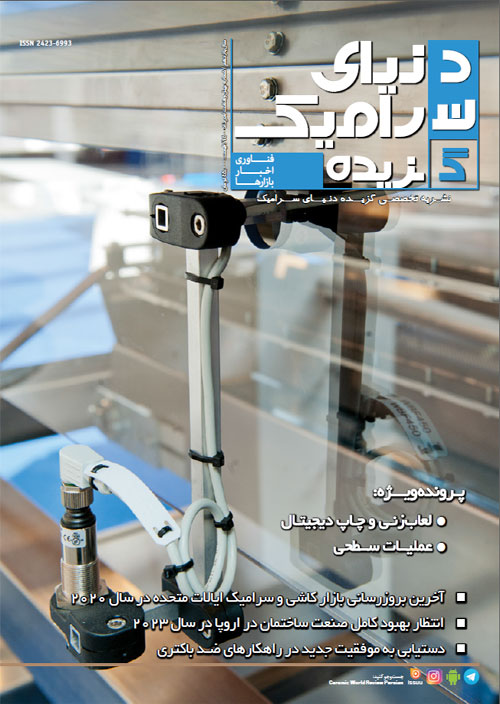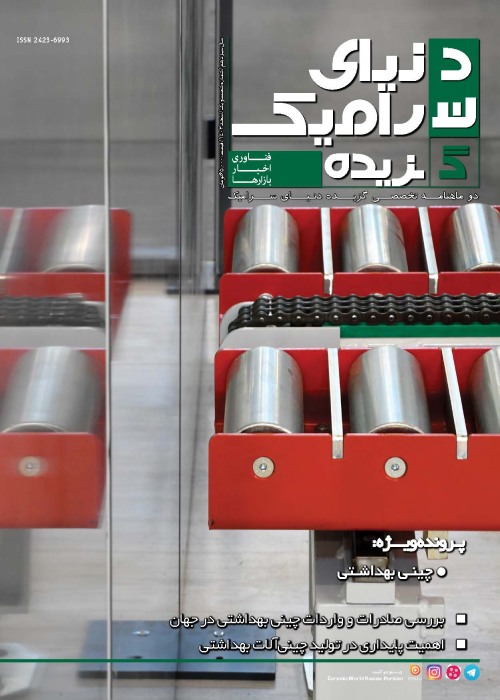فهرست مطالب

فصلنامه گزیده دنیای سرامیک
پیاپی 48 (امرداد 1400)
- تاریخ انتشار: 1400/06/28
- تعداد عناوین: 19
- سرمقاله
- اخبار جهان
-
صفحه 10
- اقتصاد
- پرونده ویژه: لعابزنی و چاپ دیجیتال
- دستاوردها
- پرونده ویژه: عملیات سطحی
-
Page 32
The year 2020 was extremely difficult for the U.S. economy, which was devastated by the COVID-19 health crisis, and consequently, for the U.S. ceramic tile market, which declined for the second consecutive year following nearly a decade of uninterrupted growth. While some segments of the economy remained healthy, the pandemic’s impact sent U.S. gross domestic product (GDP) to a 3.5% decrease from the previous year (Bureau of Economic Analysis). This was the country’s worst economic decline since 1946 and its first contraction on an annual basis since the Great Recession in 2008-2009. According to the figures provided by the Bureau of Labor Statistics, the pandemic also pushed U.S. unemployment to 8.1% in 2020, its highest level in eight years.
-
Page 38
The sudden and totally unexpected Covid-19 pandemic has dramatically changed the prospects for the construction market, opening up a new phase that has totally overturned all estimates. According to the latest Euroconstruct forecast, presented in Munich during the conference held on 24 November last year, the construction volume in the area is estimated to have slumped by 7.8% in 2020. This marks the second upward revision after the -11.5% forecast in June was updated to -9.1% in August.
-
Page 40
With a new name, a more agile exhibition format, the highest safety standards and a wide range of new services, Tecna (formerly Tecnargilla) will be back as an in-person show , reasserting its role as the world’s most important exhibition for supplies to the ceramic industry. This is excellent news, because at such a complex and challenging time for industry in general the ceramic machinery sector needs to come together at a suitable physical location where it can reaffirm its innovative nature and its role as an incubator of ideas and above all resume face-to-face meetings with customers, three years after the last edition of Tecnargilla held in 2018.
-
Page 42
The digital revolution represents a cultural shift within the ceramic industry and involves all stages of the production process, in-cluding decoration. Digital printing is the latest step in an evolutionary process that began some 50 years ago with flat screen print-ing, followed in the 1990s by Rotocolor and in the early 2000s by dry application of coloured grits. This development arc was inter-rupted by the advent of digital, a disruptive technology that dramatically changed the way factories are organised and transformed ceramic products and the type of materials now supplied by the glaze and colour producers. The development of digital technolo-gy has been accompanied by the diffusion of continuous pressing systems and other solutions suitable for forming large slabs, the development of high-performance printheads capable of laying down material in ever greater quantities, and the adoption of the Industry 4.0 model of the completely digital factory.
-
Page 46
The ongoing market trend towards ever more sophisticated products in terms of aesthetics and material effects has prompted the leading players in the field of industrial automation for the ceramics industry to develop technological solutions capable of meet-ing this need. Creadigit Infinity, the latest innovation in the field of digital decoration developed by System Ceramics, is the concrete answer to this new challenge, a technology with unprecedented computing power that opens up exclusive new aesthetic scenarios.
-
Page 48
The need to diversify ceramic products more effectively in the age of digital decoration is the key driver behind the research con-ducted by technology and raw material suppliers and by ceramic companies’ R&D laboratories. Over the years, the introduction of new digital printing techniques has brought major aesthetic and economic benefits, but at the same time has resulted in a certain degree of standardisation and lack of diversity in terms of product aesthetics. This is why it is essential for research aimed at achieving greater product differentiation to focus on the use of typical ceramic materials in con-junction with modern digital application technologies.
-
Page 50
In keeping with its commitment to sustainability and the environment, the Esmalglass-Itaca Group has developed and implement- ed a new family of water-based digital glazes aimed at accompanying ceramic producers on their journey towards greater sustaina-bility. Called DigitalGlass, the new digital solution reduces water consumption by a factor of ten compared to traditional glazes. Fresh water is an increasingly scarce commodity on the planet, so every drop of water is important for building a more sustainable future. Reducing water consumption tenfold through the use of new water-based digital glazes brings environmental benefits as well as improving the industry’s production activities. As the culmination of more than a decade of hard work and dedication, Digi-talGlass is a truly revolutionary solution for the ceramic industry.
-
Page 52
The environmental impact analysis of a technology is not limited to the specific production phase in which it is used but involves the entire production process. In this respect, full digital ceramic decoration is a highly sustainable technology that contributes to a more sustainable overall process by consuming fewer resources and producing lower emissions and waste. The use of water-based inks and glazes brings technical benefits as well as significant savings in terms of production costs.
-
Page 54
The road to the future is never travelled alone but involves successful collaboration between all the players involved. Nowhere is this more evident than in the field of ceramic digital printing, where the latest and most innovative solutions are being developed jointly by the leading companies in the fields of materials, colours and glazes and application technology.
-
Page 56
In recent months, the renowned ceramic glaze and colour producer Sicer has developed a brand new range of inks at its Digital R&D Lab with the aim of offering tile manufacturers the choice of different combinations for achieving perfect four-colour printing. The new Custom SCD2000 range consists of a series of different inks that allow users to choose the most suitable four-colour combination for their needs. For years now, Sicer has been offering tile producers the potential to achieve excellent results and a unique gamut extension using a six-colour process, in other words through the addition of the special inks Vibrant Red SCD088 and Brilliant Yellow SCD018. The aim of the Custom SCD2000 series is to ensure much better results with the four-colour process without the need to use two additional colour bars. The Custom SCD2000 series consists of a new black ink, SCD2071, which is also highly effective at creating absolute black surfaces, a new cyan SCD2062, three different honey/yellow inks and two red brown/orange inks. This new series results in a much wider colour gamut than the traditional four-colour process, particularly in the areas where the standard gamut can sometimes prove inadequate, namely orange, red, yellow and green.
-
Page 58
Innovation is part of the DNA of Torrecid Group, leading it to develop new solutions capable of revolutionising processes and products and driving future trends. In other words, the group’s longstanding aim is to cause change through global leadership in innovation to generate new solutions and future trends capable of providing the best competitive advantages and the greatest added value to its customers. Far from being an ephemeral trend, this quest for ever more advanced, cuttingedge materials has guided all the group’s actions and decisions over the years and has led to the development of groundbreaking solutions that have transformed the ceramic in-dustry, from monoporosa tiles to the digital revolution and today’s fully digital decorative processes capable of offering a wide variety of reliefs, effects and finishes.
-
Page 66
The digitalisation of industrial processes in accordance with Industry 4.0 principles now dominates the technological development efforts of the most advanced companies. New factory requirements range from the need for detailed productivity and cost meas-urements to plant flexibility in changing business models to ensure the highest levels of production efficiency at all times.
-
Page 68
The surface functionalisation of ceramic tiles and slabs is becoming an increasingly important requirement in response to the growing attention to the health and safety of the people who come into contact with these surfaces in their daily lives. Improving cleanability is no longer sufficient and, depending on their application, surfaces also need to be super-glossy, non-slip and water-repellent, as well as having antibacterial properties. NoCoat, the Surfaces Group brand devoted to surface treatment and protection products specialising in the functionalisation of ceramic surfaces, has concentrated its activities in this field of research. Renowned both in Italy and in the most important international markets, NoCoat products are manufactured at the Surfaces Group’s new Sassuolo site in the heart of the Italian ceramic district, where all the chemical treatment production, logistic and commercial activities are now based.
-
Page 70
As part of its journey towards increasingly digitalised smart factories, the ceramic sanitaryware industry requires advanced quality control departments capable of identifying, controlling, classifying and tracking pieces in a precise, objective and repeatable man-ner. To meet this need, Sacmi has developed a new solution for fully automatic inspection of fired pieces capable of eliminating all variability in terms of response and ensuring far greater precision than even the most experienced and expert human eye. As well as saving time, SACMI D3 Qualitrack ensures the highest levels of efficiency in the management of sorting operations.
-
Page 72
Over the last decades, the seaside town Jesolo hosted some of the most important Italian and international architects. The interventions for tourism have involved measures of urban redevelopment, from luxurious hotels to residences on the promenade, from the green lung to bio-building, from the skyscrapers to the commercial areas. Modernity is melted with the identity of a city focused to the change of lifestyles, to the principles of sustainability and to the environment quality.
-
Page 74
The Park Lane ala Moana is the newest, most exclusive, luxury beachfront development in a city known for luxury beach-front developments. But rather than add another highrise condo to Honolulu’s skyline, AMX Partners, LLC decided to build a luxury low-rise community of 217 private residences with floor plans ranging from 150 sq.m to more than 560 sq.m.


